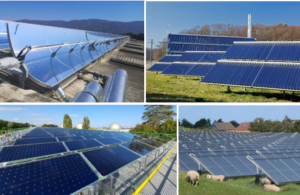“2030 is tomorrow but we still do not have the whole picture”
May 31, 2023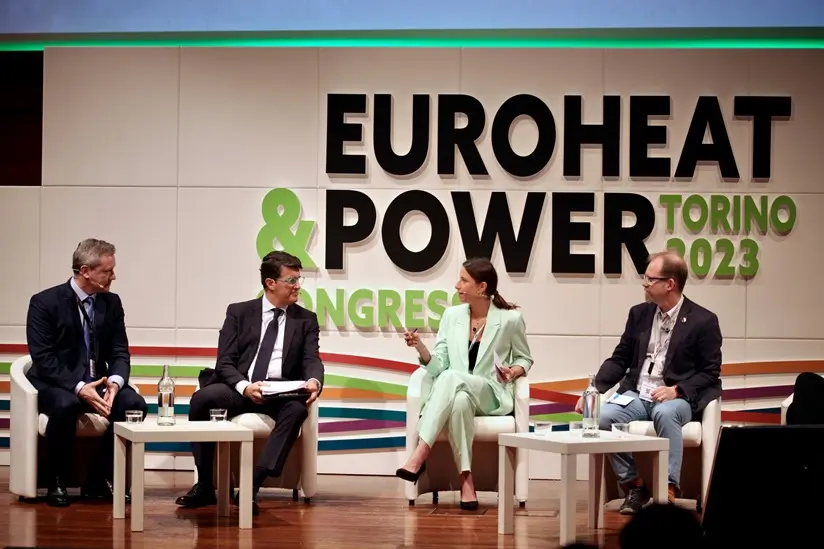
The district heating sector is getting more and more attention. The first International Euroheat & Power Congress after four years was booked out – both in terms of participants and exhibition area. More than 450 experts met in the northern Italian town of Turin from 22 to 24 May and discussed decarbonisation strategies, digital solutions, local heat communities and the market outlook. Solar thermal experts were present for several sessions and made clear that solar heat is a perfect team player with other solutions. Two utility companies from Poland confirmed plans to rely on solar district heating as part of their strategies to phase out coal.
Photos: Euroheat & Power
The opening panel discussion moderated by Euroheat & Power´s Managing Director Aurélie Beauvais set the scene for the whole conference (see photo above). Two Danish industry representatives from Logstor and Danfoss reported from this pioneering country – and also addressed the most important challenges that the district heating market is facing there.
District heating’s future is digital
“We are in a very exciting time, when heat security and heat affordability are the key drivers for the energy transition,” said Terry McGivern from Logstor, Denmark. He reported that 58,000 Danish households connected to the district heating grid in 2022 – a doubling compared to the previous year. But this was only possible because of an enormous infrastructure effort. McGivern named two major challenges: “We need dedicated areas for district heating and then all buildings need to be connected and the public buildings should be first. But we also need transparency about the prices in these zones.”
“The heat utilities in Denmark are very cost-competitive because they use multiple sources,” added Saska Rihtarsic, Vice President District Energy at Danfoss. She saw the main obstacle in the fact that the “networks are getting more and more complex”. Digitalisation is the solution. Danfoss is in the process of completely restructuring its workforce. “50 % of our engineers today are experts for digital services and no longer mechanical engineers”, she reported. It is not about hardware any more. Rather strategies for regulation of the networks and services to the customers are the key elements of the business. According to Rihtarsic the first step towards digitalisation is that “we need heating systems in buildings to be digital-ready so that they communicate and provide their data”. The next step is to get the real-time data from the clients into a cloud and analyse it to run the network more efficiently, even via a digital twin.
The panellists agreed that district heating has never been more relevant than today. But the sector needs to defend its position against hydrogen. “We do not have an equal playing field yet. There is a lot of money going into new technologies such as hydrogen,” Joakim Byström, CEO of Absolicon in Sweden, pointed out. He added that “it is difficult to make short-term profit from a new district heating system, but with low capital costs utilities can plan into the future and shift to renewables”.
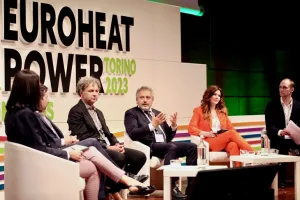
Panel discussion about the decarbonisation strategies of coal-fired district heating with, among others, Thomas Jahrfeld from Stadtwerke München in Germany (third from left) and Wanda Buk from PGE Group in Poland (second from right)
Poland’s strategy to phase out coal leads to solar district heating
The second panel discussion under the title “Green is the new black – unleashing the potential of climate-neutral DHC” demonstrated impressively the various paths that utility companies take to shut down their coal-fired combined heat and power plants.
Stadtwerke München, the municipal utility company of Munich, Germany, wants to transform the heat supply into geothermal. The company plans to drill 17 new geothermal wells in the city area to enable them to shut down the coal-fired plant of around 100 MW by 2025. Thomas Jahrfeld, Member of the Board of Stadtwerke München, explained that it took them five years to build a 15 km pipeline to a village outside the city, so they need to get much faster. Solar heat is not yet part of this strategy.
PGE Group, the largest district heating provider in Poland, which supplies heat to two million households and operates 16 coal-fired power plants, has worked intensively on its decarbonisation strategy over the last two years. Wanda Buk, Vice President for Regulatory Affairs at PGE, explained that PGE cannot rely solely on gas for its strategy to phase out coal because gas will get too expensive due to the EU emissions trading system. Instead Buk presented a map where a mix of different technologies such as heat pumps, electro boilers, biomass and solar will replace most of the coal-fired boilers. For two sites – Zawidawie and Zgierz in central Poland – solar district heating plants are planned (see chart below). When asked after the panel Buk confirmed that due to the Ukraine war, an update of the strategy is currently under development that will include even more solar heat plants.
The panellists agreed that the EU is setting tight targets for energy efficiency and decarbonisation already for 2030, but the utility sector still lacks framework and regulations from the national governments. “2030 is tomorrow but we still do not have the whole picture,” summarised Buk in her final statement.
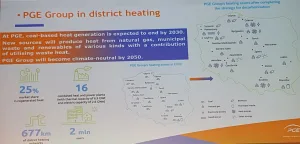
PGE Group´s decarbonisation startegy on one page
Another investor for a large solar thermal system in Poland might be the utility company Fortum. Conference attendee Magdalena Lamasz-Kowalska, Fortum´s Procurement Manager Heating and Cooling, confirmed that she will soon be inviting tenders for the planning and implementation of a multi-MW solar district heating plant. Fortum plans to stop using coal in 2025.
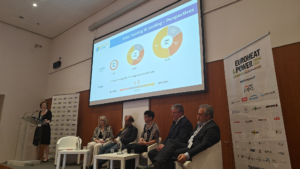
Valérie Séjourné, the new Managing Director of Solar Heat Europe, opened a special panel discussion titled “Decarbonisation of District Heating: The Case for Solar Thermal Solutions” on the second day of the conference.
Seasonal storage is a perfect match for a multi-energy-sources approach
Solar district heating is a very good team player in district heating grids together with heat pumps, seasonal storage and biomass boilers. This was one of the key take-aways of the dedicated solar district heating panel discussion on the second day of the conference. Representatives of utilities using solar district heating successfully made the point about the cost-competitiveness of solar heat. “Our customers profit from stable and low heat prices because of our high renewable share,” emphasised Ina Berziņa-Veita, CEO of the Latvian utility company Salaspils Siltums. Her company has operated a 15 MW collector field since September 2019. The CEO made clear that the multi-day storage of 8,000 m3 was a very good investment. “By using the storage volume in an optimised way we have been able to increase the annual solar share within the total heat demand in our network from 16 to 20 %”
“In the next two to three years we will see a lot more really large district heating plants in Europe. A combination with seasonal storage is a perfect match for district heating networks based on multiple energy sources”, said moderator Guglielmo Cioni, Vice President of Business Development at TVP Solar, summarising the discussion.
Websites of organisations mentioned in this news article:
Euroheat & Power Congress 2023: https://www.ehpcongress.org/
Logstor: https://www.logstor.com/
Danfoss: https://www.danfoss.com/en/
Stadtwerke München: https://www.swm.de/
PGE Group: https://www.gkpge.pl/en/pge-group
Absolicon Solar collectors: https://www.absolicon.com/
Fortum: https://www.fortum.com/
Solar Heat Europe: http://www.solarheateurope.com/
Salaspils Siltums: https://salaspilssiltums.lv/
TVP Solar: https://www.tvpsolar.com/

